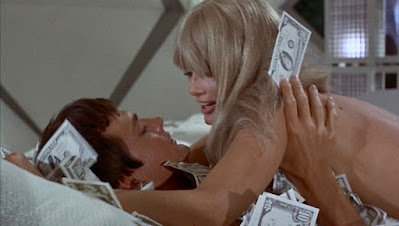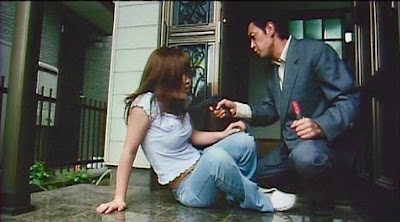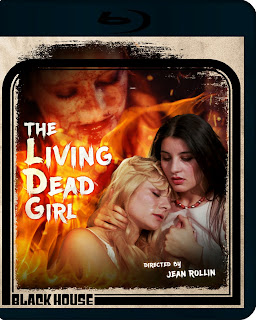This was the first Rollin movie I ever saw, many years ago, and it made me an immediate Rollin fan. I’m now the proud owner of a copy of the Redemption Blu-Ray release so it’s time to take another look at this movie.
It opens with one of the many extraordinary iconic images that Rollin offered us over the years (other that come to mind are Brigitte Lahaie with the scythe in Fascination, the vampires coming out of the clock in Shiver of the Vampires and numerous images in The Iron Rose). Two girls dressed as clowns are making their getaway in a car after an armed robbery. Their driver doesn’t make it and the girls set off on foot.
Why are the girls dressed as clowns? That’s simple. This is a Jean Rollin film and Rollin was first and foremost a surrealist. If you explain a surrealist image it loses its magic.
The girls are Marie (Marie-Pierre Castel) and Michelle (Mireille Dargent). They are lesbians. So far we have clowns, doubles and lesbians, and vampires are about to make their appearance, so you know this is definitely a Jean Rollin film.
The girls steal a motorcycle and end up at the château. The château is inhabited by vampires, or at least by one vampire and his followers. He is the last vampire, but his followers hope to become vampires. Erika (Dominique) has already grown fangs.
The girls are not held prisoner, except that they are in reality prisoners. They can leave the château but no matter which road they take it will always lead them back to the château.
The vampires have a kind of larder in the dungeon - a number of young women chained up who serve as a food supply. They also provide sexual entertainment for the vampires’s male followers. Whether these young women are innocent victims or willing participants in the perversity is left rather ambiguous.
Marie and Michelle are not to serve as vampire food. They are to be initiated which will begin their transformation into vampires. There is one slight problem, the vital question of whether or not the girls are virgins. They are in fact virgins but turning a virgin into a non-virgin is not a difficult task. In fact Marie approaches it with enthusiasm.
Michelle seems to like the idea of becoming a vampire. Marie isn’t so sure. The girls are supposed to lure victims back to the château but Marie decides that the man she’s trying to ensnare is kind of cute and rather nice. This will lead to trouble.
If I’ve given you the impression that this movie has a straightforward linear narrative then I apologise. Early Rollin vampire movies such as this one do not bother overmuch with conventional narrative. Rollin simply serves us up a succession of striking images, and the images are enough to make the film worthwhile. Louise (one of the vampire’s acolytes) playing the piano in the graveyard is one such image (and it was apparently the image that Rollin came up with first and from which he built the entire film).
One thing that is sometimes overlooked is that Rollin had a great fondness for movie serials, both the French serials of the early 20th century and even more especially for American movie serials of the 30s and 40s. These movie serials had a major influence on the way Rollin structured his narratives. Some of the outrageous elements in the plot of Requiem for a Vampire are inspired more by the delirious fun of movie serials than by artiness.
This movie is a good example of Rollin’s attempts at this stage of his career to combine the surrealist artiness which he loved with commercial exploitation elements. And there are enough exploitation elements to keep any exploitation fan happy - there’s copious female frontal nudity, bondage and plenty of sadomasochism. The scene with the presumably vampiric bat apparently feeding between a naked girl’s thighs is one of the more outré images in the film.
Which also explains why Rollin, despite the fact that he was a genuine master of surrealism, had so much trouble getting taken seriously in France.
Rollin tended to cast his actresses as much as anything for their visual suitability. That meant that they had to be pretty but with the kind of prettiness that would fit the visual tone of a particular movie. They needed to be competent but not necessarily especially accomplished actresses. Marie-Pierre Castel and Mireille Dargent are perfect for his purposes, as is Dominique as the sexy but predatory Erika - she really looks like a glamorous lady vampire, seductive and beautiful but in a weird otherworldly way.
Redemption’s Blu-Ray release looks very impressive and includes plenty of extras.
Requiem for a Vampire is certainly a vampire movie and it contains plenty of the elements you’d expect to find in a gothic horror movie, but it’s not really a horror movie. It’s a poetic melancholy movie about love, sex and death, and dreams that pass away, and about loss. It’s a world away from conventional vampire movies, and it has little in common with the lesbian vampire movies of that era such as Hammer’s The Vampire Lovers or Jose Larraz’s Vampyres. It doesn’t even have much in common with Jess Franco’s lesbian vampire movies like Vampyros Lesbos and Female Vampire. Rollin’s vampire movies formed their own unique genre.
Requiem for a Vampire is a strange surreal and entrancing mood piece. Very highly recommended.









































